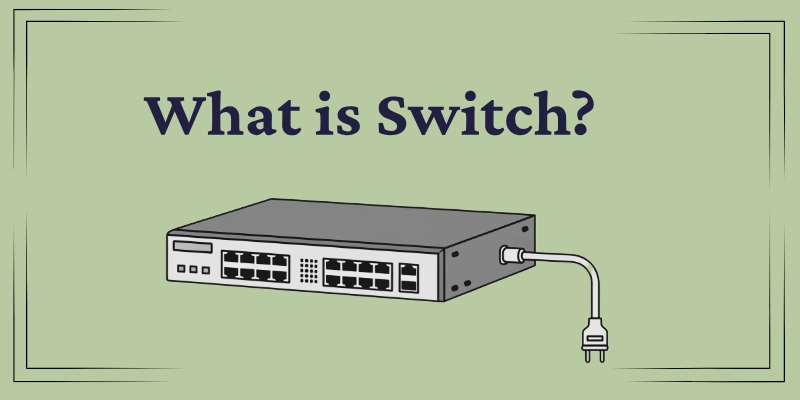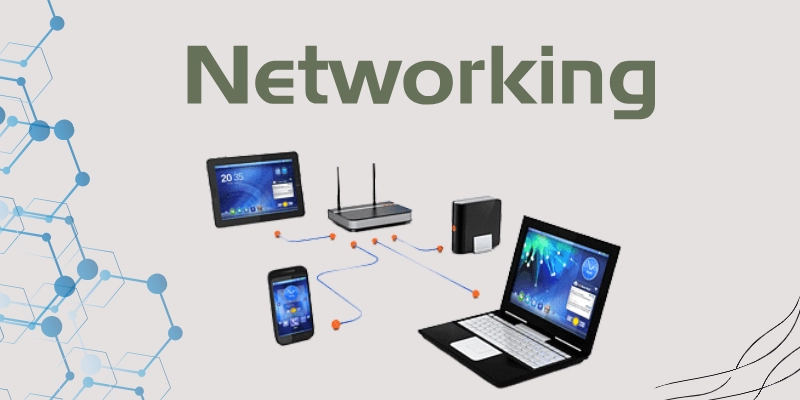What is Switch? Definition, Types, and Applications Across Fields
Published: 11 Sep 2025
The word switch carries different meanings across technology and engineering from networks and computer science to electronics, programming, operating systems, telecommunications, and even cloud platforms. Although the context varies, the core idea stays the same: it’s a component or mechanism that directs the flow of data, electricity, or processes by selecting between available paths.
In this article, we’ll look at how switches function in these diverse areas, giving you a clear and well-rounded understanding of their role and significance.
What is Switch?
A switch is a fundamental concept used across multiple fields of technology and engineering. At its core, a switch is something that controls the flow of data, power, or processes by selecting between available paths. While the details differ from one discipline to another, the principle remains the same: it enables control and direction.

Common Functionality of Switches
- Control – Switch ON/OFF or choose a path.
- Direction – Route signals, packets, or instructions.
- Efficiency – Improve performance and organization.
The following are the different contexts in which the term switch is used:
- Switch in Networking
- Switch in computer science
- Switch in electrical circuits
- Switch in electronics
- Switch in Java programming
- Switch in C programming
- Switch in operating systems
- Switch in telecommunication
- Switch in cloud computing
1. Switch in Networking
In computer networking, a switch is a hardware device that connects multiple devices (computers, printers, servers, etc.) within a Local Area Network (LAN) and forwards data intelligently.
How It Works
- Switches operate mainly at Layer 2 (Data Link Layer) of the OSI model.
- They use MAC addresses to learn which devices are connected to which ports.
- When a device sends data, the switch checks its MAC address table and forwards the frame only to the correct destination instead of broadcasting to all devices.
This makes switches far more efficient than hubs, which simply broadcast data to all ports.
Switch vs. Router vs. Hub
Following is the comparison table of Switch, Router, and Hub for better understanding.
| Device | Function | Efficiency |
| Hub | Broadcasts data to all ports | Low |
| Switch | Forwards data to specific device using MAC address | High |
| Router | Connects different networks (LAN to WAN/Internet) | Very High |
Types of Network Switches
The following are the main types of network switches explained for easy understanding.
- Unmanaged Switch – Simple, plug-and-play, used in small offices and homes.
- Managed Switch – Configurable, supports VLANs, QoS, monitoring, enterprise networks.
- Layer 2 Switch – Works at Data Link Layer, uses MAC addressing.
- Layer 3 Switch – Adds routing capabilities, forwards packets using IP addresses.
- Modular/Chassis Switch – Scalable, high-performance, used in data centers.
Applications in Networking
The following are some common applications in networking that highlight its practical use.
- Expanding LAN connections.
- Segmentation of networks using VLANs.
- High-speed communication in data centers.
- Load balancing and redundancy.

2. Switch in Computer Science
In computer science, a switch is a control mechanism that allows a program, system, or device to choose between multiple execution paths or operations.
It can refer to:
- Networking switches – connecting devices.
- Programming switches – flow control (switch statements).
- OS switches – context switching in process management.
In general, computer science defines a switch as a decision-making construct that controls flow, whether in hardware (networking) or software (logic control).
3. Switch in Electrical Circuits
In electrical engineering, a switch is a device that opens or closes an electrical circuit, allowing or stopping the flow of electric current.
How It Works
- Closed switch: Circuit is complete, current flows.
- Open switch: Circuit is broken, no current flows.
Common Types of Electrical Switches
Below are the common types of electrical switches explained for better understanding.
- Toggle Switch – Flips between ON and OFF.
- Push Button Switch – Used in doorbells, calculators.
- Rotary Switch – Rotates between multiple connections.
- Limit Switch – Activated by physical movement.
4. Switch in Electronics
In electronics, a switch is also a control component used in circuits, but here the emphasis is on low-voltage and signal-based control.
Examples include:
- Electronic switches (transistors, MOSFETs) – Act as switches for signals.
- Membrane switches – Used in keyboards and remote controls.
- Solid-state switches – Faster, more reliable than mechanical switches.
Thus, in electronics, a switch is not always mechanical; it can be semiconductor-based.
5. Switch in Java Programming
In Java, the switch is a control flow statement used to execute one block of code out of many options based on the value of a variable.
Example:
int day = 3;
switch (day) {
case 1: System.out.println(“Monday”); break;
case 2: System.out.println(“Tuesday”); break;
case 3: System.out.println(“Wednesday”); break;
default: System.out.println(“Invalid day”);
}
👉 Output: Wednesday
This is more efficient than multiple if-else statements when there are many conditions.
6. Switch in C Programming
In C language, the switch statement works similarly to Java. It evaluates an expression and jumps to the matching case label.
Example:
int num = 2;
switch(num) {
case 1: printf(“One”); break;
case 2: printf(“Two”); break;
case 3: printf(“Three”); break;
default: printf(“Invalid”);
}
👉 Output: Two
Both C and Java implement switches as multi-way decision constructs.
7. Switch in Operating Systems
In operating systems (OS), the term “switch” usually refers to context switching.
What Is Context Switching?
- In multitasking OS, CPU must switch between processes
- Context switch saves the state of one process and loads another.
- This ensures fair CPU sharing among tasks.
8. Switch in Telecommunication
In telecommunications, a switch is a system that connects calls or data sessions by directing them through available communication paths.
Telephone Switching
- Old systems used circuit switching (dedicated path per call).
- Modern telecom uses packet switching (data split into packets, routed dynamically).
Importance
- Connects millions of users worldwide.
- Provides reliability and efficient use of bandwidth.
9. Switch in Cloud Computing
In cloud computing, a virtual switch (vSwitch) is a software-based switch that enables communication between virtual machines (VMs), physical servers, and networks.
Role of vSwitch
The role of a vSwitch in networking is explained below for clear understanding.
- Directs traffic between VMs inside a host.
- Connects virtualized environments to physical networks.
- Supports VLANs and network security policies.
Examples:
- VMware vSwitch
- Microsoft Hyper-V vSwitch
- Open vSwitch (OVS)
Conclusion
A switch is a universal concept applied across multiple domains:
- In networking, it connects devices efficiently in a LAN.
- In computer science/programming, it decides execution flow.
- In electronics and electrical circuits, it controls current.
- In operating systems, it handles context switching.
- In telecommunication, it directs calls/data.
- In cloud computing, it manages VM traffic with virtual switches.
👉 No matter the context, a switch always performs one fundamental role:
it manages flow and makes choices between multiple paths.
Got questions or feedback? 💬 Drop a comment ✍️ and let us know what you think.
FAQs
The following are some frequently asked questions about switches:
A switch helps control the flow of data, electricity, or processes depending on the field. In networking, it connects devices and forwards data efficiently. In electronics or circuits, it simply turns current on or off.
A switch connects devices within the same local network, like computers and printers. A router connects different networks together, such as your home LAN to the internet. Simply put, switches manage local traffic, while routers manage external connections.
Yes, but it’s not recommended. A hub sends data to all devices, wasting bandwidth and creating collisions, while a switch sends it only where it’s needed. That’s why switches are more secure and efficient.
In programming languages like Java or C, a switch is a control statement. It checks the value of a variable and runs the matching code block. This makes code shorter and easier to manage compared to multiple if-else statements.
A virtual switch (vSwitch) is software that acts like a physical switch inside a virtual environment. It allows virtual machines (VMs) to communicate with each other and with external networks. vSwitches also help manage security and traffic in cloud setups.
Switches are everywhere inside your light switch, your Wi-Fi router, your computer, and even your smartphone. They make it possible to control processes, direct data, and save resources. Without switches, most modern technology wouldn’t function properly.

- Be Respectful
- Stay Relevant
- Stay Positive
- True Feedback
- Encourage Discussion
- Avoid Spamming
- No Fake News
- Don't Copy-Paste
- No Personal Attacks

- Be Respectful
- Stay Relevant
- Stay Positive
- True Feedback
- Encourage Discussion
- Avoid Spamming
- No Fake News
- Don't Copy-Paste
- No Personal Attacks





